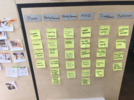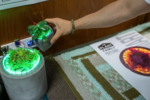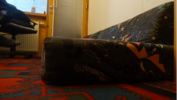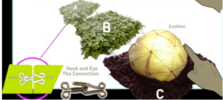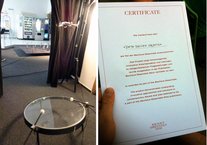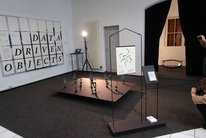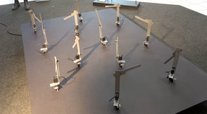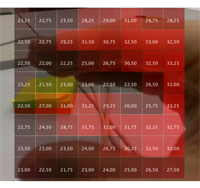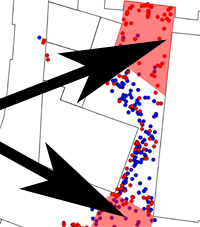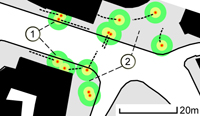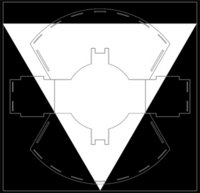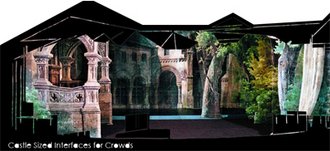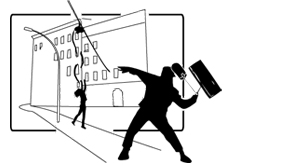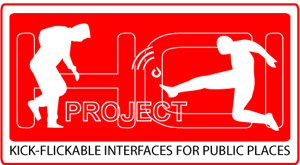Only a selection...
see the teaching section/heading for a complete list of projects per semester
or the news section and exhibition & performances section (within publications) for details on some projects...
Smart Homes
Over the last two years, we undertook a series of projects that dealt with smart home technology and our potential interactions with smart homes. As these technologies are often promised to be just around the corner, we wanted to explore what this might look like through a couple of conceptual and speculative designs.
In SoSe 2019 , we started with the project Beyond Smart in which we gained insight into people’s lived experiences, that go beyond the sterilised views in which smart homes are often presented. After doing research with Cultural Probes in the form of a game as well as via Contextual Inquiry of cooking and eating dinner together with participants, students developed two speculative artefacts to encourage people to get together and communicate more:
- A smart flower pot that grows lonely over time and needs people to get together to make it happy again
- A collaborative drum table that enables contact in a playful and engaging manner.
In WiSe 19/20, we explored this from the perspective of smart textiles. In contrast to the “black boxes” of many existing smart home technologies, we turned to the rich interactions people can have with the technologies that surround them. After extensive research with participants, we developed two prototypes:
- a cuddly toy that helps parents to get their children ready when leaving the house by predicting the weather in an engaging and inspirational manner
- a series of carpet tiles with interactive functions which might support international students to feel more at home in student dorms by enabling communication and social exchange.
During the Corona Pandemic in SoSe 2020 we explored how people interact with technologies in the home more generally, e.g. exploring the role of technologies in spirituality, and using a diary method to learn about peoples’ fears and wishes about smart home automation.
Taken together, these projects have led to novel insights into how we interact with technology in the home and what we expect from it from a variety of angles.
Data-Driven Objects: Physicalization of Data
The Data-Driven Objects project was conducted by an interdisciplinary student team (2x product design, 2x HCI, 2x CS) and supervised by Hannes Waldschütz and Eva Hornecker. The course topic was physicalization - making data legible and physical. At the start of the semester we dove into literature on InfoViz, Physicalisation, Shape-Change, worked with motors and movements, as well as building simple physicalizations based on an existing creativity exercise. We then engaged in iterative idea brainstorming on data sources and designs, before picking two concepts and moving into the development phase.
Trommelwirbel gets realtime data from Aachen-based TRDM website that monitors radiation from the Belgian Tihange and Doel reactors via a citizen-based sensor network. The drum evokes the omnipresent threat of atomic radiation, where beat frequency reflects changes in sensor data. Bellum omni contra omnes - the war of all against all - takes data from a website showing cyberwarfare attacks. These anonymous soldiers (for the 16 most active origin-countries) enact the real-time attacks.
Building this has been a huge effort, and the team stood up to the challenge, hands-on supported by our HCI-member Hannes, working on interpreting, streaming and filtering the real-time data from both websites, building the electro-mechanical installation and controlling it, getting done just in time for the Summaery and exhibiting from Thursday afternoon to Sunday. The resulting work was selected by the Jury for the Marke.6 Bauhaus-Essentials 2018 (this time a publication), along with 14 other works from over 50 contestants. (see also our News article from Summaery 2018)
Trommelwirbel later was exhibited from May 4th to 22th of June 2019 at Galerie Eigenheim, Berlin. We were truly honoured to have been invited to present alongside actual artists for the exhibition 'EGO vs. ECO'... (egoism vs. ecology)!
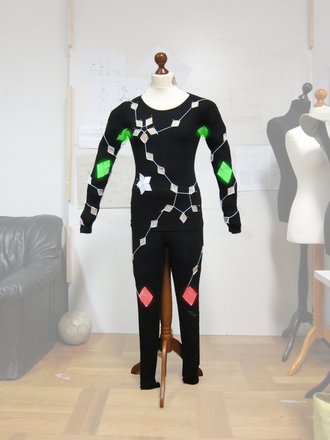
Interactive Costumes – Selfmade/Exploring Textile Sensors
We explore e-textiles and wearables in this course. Our focus lies on the use of (inter)active costumes in dance performances. This project depends on the cooperation between creative and technical development. Students from Computer Science & Media, Human-Computer Interaction, Media Art & Design, and Product Design work collaborative during the classes. They form the whole process together in teams and develop individual costume solutions with unique DIY sensors or existing textile-able sensors. For this, we use e.g. conductive fabrics and yarns, flex sensors, force sensors or accelerometers. Furthermore, we explore technologies like the LilyPad Arduino.
Additionally, we collaborate with a young dance group (Kinder- & Jugendballett Landestheater Altenburg) in order to bring our project outcomes live on stage. We evaluate how the dancers adapt to our costumes and how such innovations could enhance dance performance.
More infos on our blog!
Mermaids do not exist? Interactive Costumes do!
In cooperation with the Kinder- & Jugendballett in Altenburg we are going to create two interactive costumes for an underwater topic. Next to soft-/hardware development and crafting the costume, the main research focus lies on the power of e-textiles in performance arts. Technologies used include Arduino LilyPad, Processing/Java, Neopixels, conductive/resistive fabrics and threads. The project will be completed by a qualitative user study (attending rehearsals, test sessions with dancers, interviewing staff). The costumes will be used on stage in June 2017.
> more ...
> im Vorlesungsverzeichnis
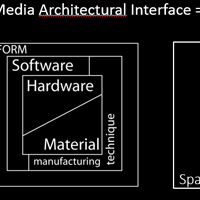
Architectural Sized Interfaces
The aim of this project is the design and implementation of an architectural interface prototype based on sensors from industrial factories and recycled/ repurposed furniture or self-constructed ultra-lightweight and low-cost building structures (popup tents, sails, etc.). Additionally, it should support group interaction and social opportunities for the city scape. To test the interface we will use projection mapping, which has proven able to simulate various media architectural output displays. We plan to setup a lightweight backyard test laboratory in which the interface can be tested on a building façade.
> more ...
> im Vorlesungsverzeichnis
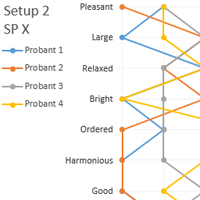
Evaluating behaviour and experience around public interfaces
We will review evaluation methods from User Experience Design, Social Sciences, Architecture and Environmental Psychology. The focus lies on methods for evaluating behaviour and experience in public space. Concepts such as Shared encounters, People as Displays and the relation of user, participant and observer will be explored. Furthermore we will actively explore multimodality and spatial concepts. We then will review evaluation approaches from past projects. In a second step, we design our own evaluation method.
> more ...
> im Vorlesungsverzeichnis
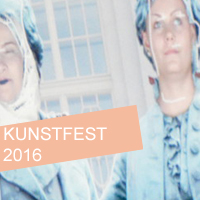
Public Interfaces for Citizen Participation (Die Ermittler - a dialogue on refuge, being strange, and home)
In this project we produced an interactive projection mapping for the Peter Weiss year in 2016. The realization was guided by the renowned pioneer of live public media art Krzysztof Wodiczko. The project was premiered in August 2016 in Weimar during Kunstfest Weimar. The student project collaborates with Anke von der Heide and Timm Burkhardt, and includes students from MediaArchitecture, design and the arts. This project is part of a larger collaboration with the faculty of Arts and Design, Kunstfest Weimar and other partners, in particular local refugees or 'newcomers' to Germany.
> more ...
> im Vorlesungsverzeichnis
> video documentation on vimeo
GridEye infrared array: Advanced low cost sensors
We will combine the panstamp wireless version of the Arduino with a low resolution thermographic camera for distributed sensing and explore standard gesture recognition methods provided by the GR Toolkit using this sensor. The goal is to create multiple wireless modules which stage user behavior in a public space. For module, interface and interaction design we will collaborate with the project group “Designing content for narrative, embedded devices in public space”.
Designing content for narrative, embedded devices in public space
In this project we explore extensively the narrative potential of low-resolution displays. We will use existing prototypes created by prior project students in order to explore the limitations of those and explore possible content dimensions such as generative content, narratives, and metaphors. To evaluate these, little iterative deployment studies in the city of Weimar will be done. In cooperation with the project “GridEye: Advanced infrared camera low cost sensors “ we will develop a new narrative public device and apply our experiences made with low resolution displays.
Exploring Interaction and Evaluation through Game Design for Master CS&M and HCI
In this project, we will learn about and make use of game design and game evaluation methods while creating and prototyping a game of your own and incorporating innovative ideas for user interaction. The first project half will focus on getting to know the literature and methods in this field, in the final half we will design and develop a game that utilizes novel ways of interaction not explored in gaming yet, and conduct an evaluation.
Orchestrating Sensors and Actuators for the Urban Environment
The digital design of public spaces still is a difficult task. In particular when developing novel interaction scenarios, an early and iterative deployment in the field is necessary so system design can take account of the real-world conditions of the public environment.
To enable a faster prototyping of such scenarios, this class will develop a software server platform in Java, which will enable the orchestration of wireless ‘interaction nodes’.
Similar to the ‘internet of things’ paradigm, a wireless network of interaction nodes is to be created, that works reliably in urban environments over a distance of up to 20 meters.
Instrumentation of Public Space for Social Interaction
Die Entwicklung neuartiger Interaktionsszenarien erfordert einen frühzeitigen und iterativen Einsatz im Feld. Besonders unser Forschungsfeld, der Stadtraum, "funktioniert" anders. Bedingungen des öffentlichen Lebens müssen in das Systemdesign mit einfließen.
Um ein schnelleres Prototyping solcher Szenarien zu ermöglichen, entwickelt dieser Kurs ein Set von drahtlosen Modulen, welche es ermöglichen Sensoren und Aktuatoren (eingebettet in Objekte) im Stadtraum frei zu verteilen. Der somit instrumentierte Raum stellt eine Experimentierplattform für verschiedene Anwendungsfälle dar, die besonders auf soziale Interaktionsaspekte fokussieren.
Castle Sized Interfaces for Crowds
Facadenmapping hat sich im öffentlichen Raum seit einigen Jahren zu einer populären Medienform entwickelt. Dabei grenzt diese sich zunehmend von Kino und Clubkultur ab und entwickelt ihre eigene Sprache und Syntax. Dieses Jahr erlaubt uns eine Kollaboration mit dem Medienarchitekturstudiengang den Schritt zum interaktiven Facadenmapping zu vollziehen. Die Produktion findet Ihr Highlight in der Premiere in Meiningen am 22. August 2014.
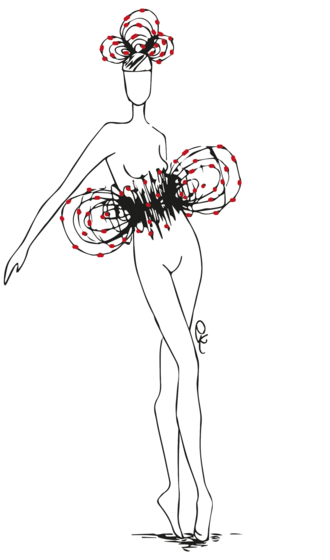
Interactive Costumes – E-textiles made for the Stage
Das Theater ist eines der ältesten Unterhaltungsformate der Menschheit und von Anfang an hatten Kostüme eine wichtige Funktion während den Theateraufführungen. Heutzutage, ist das wachsende Potential von sogenannten E-Textiles und Wearable Computing ein größerwerdendes Thema in der HCI und verwandten Gebieten. Computerisierte Bekleidung kann man bereits in verschiedenen Anwendungsgebieten finden, z.B. im medizinischen Sektor, in der Spieleindustrie oder im Bereich der Performance-Kunst. Trotzdem gibt es kaum Literatur über interaktive Kostüme auf der Theaterbühne.
Im Sommersemester 2014 bieten wir ein Studentenprojekt an, das sich mit genau diesem Thema befasst. Wir explorieren, wie interaktive Kostüme für die Theaterbühne aussehen könnten und welche grundlegenden Anforderungen bestehen. Die Aufgaben und Lehrinhalte in diesem Bereich der Human-Computer Interaction sind vielfältig, sie reichen von Physical Computing über Interaction-Design bis hin zur Performance-Kunst.
Parasite Interfaces for Public Environments
This student projekt addresses how interfaces need to be specialised for the public urban environment as their habitat. We focus on developing concepts and prototypes for displays working with daylight.
do (not) touch !
Students explore innovative interfaces in this course. They make an elaborated literature & web research on Tangible and Gestural Interaction. The team consisting of media designers as well as media scientists develops a project idea for a specific Tangible and/or Gestural Interface. In addition, a user study will be conceptualized for this interface during the semester.
Das Studentenprojekt "Distributed Kick/Flickable Interfaces for Public Places" ist einer Kollaboration zwischen MediaArchitekten und Medieninformatiker. Ziel des Projektes ist es eine Beschleunigung und Vereinfachung beim Prototypenbau von gemeinnützigen, urbanen Schnittstellen zu ermöglichen. Dabei werden Sensoren und Aktuatoren drahtlos über eine zentrale Software modular orchestriert.

